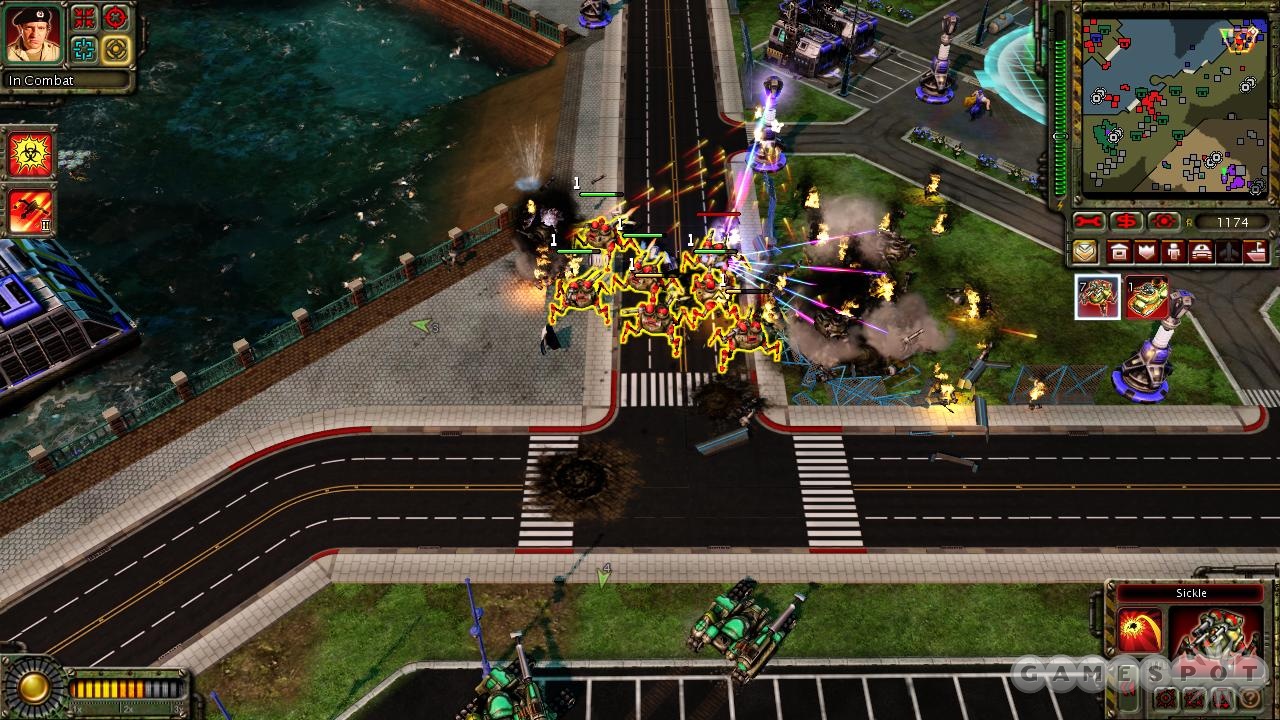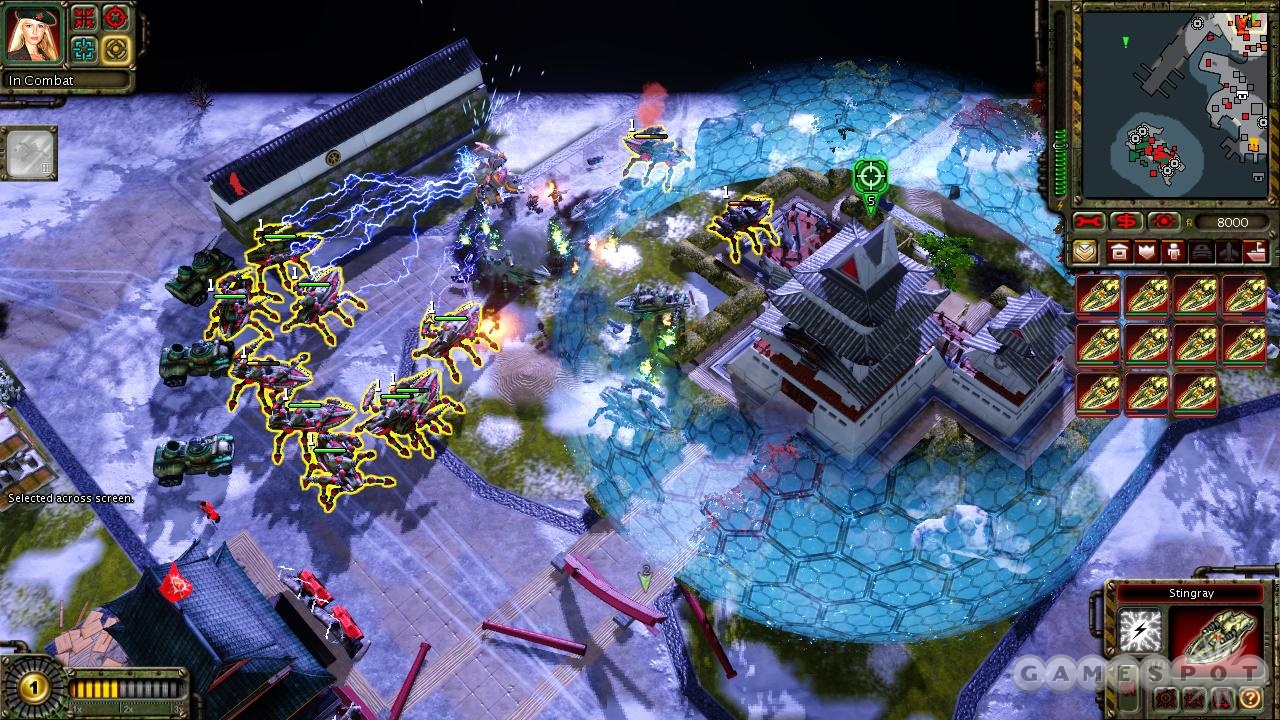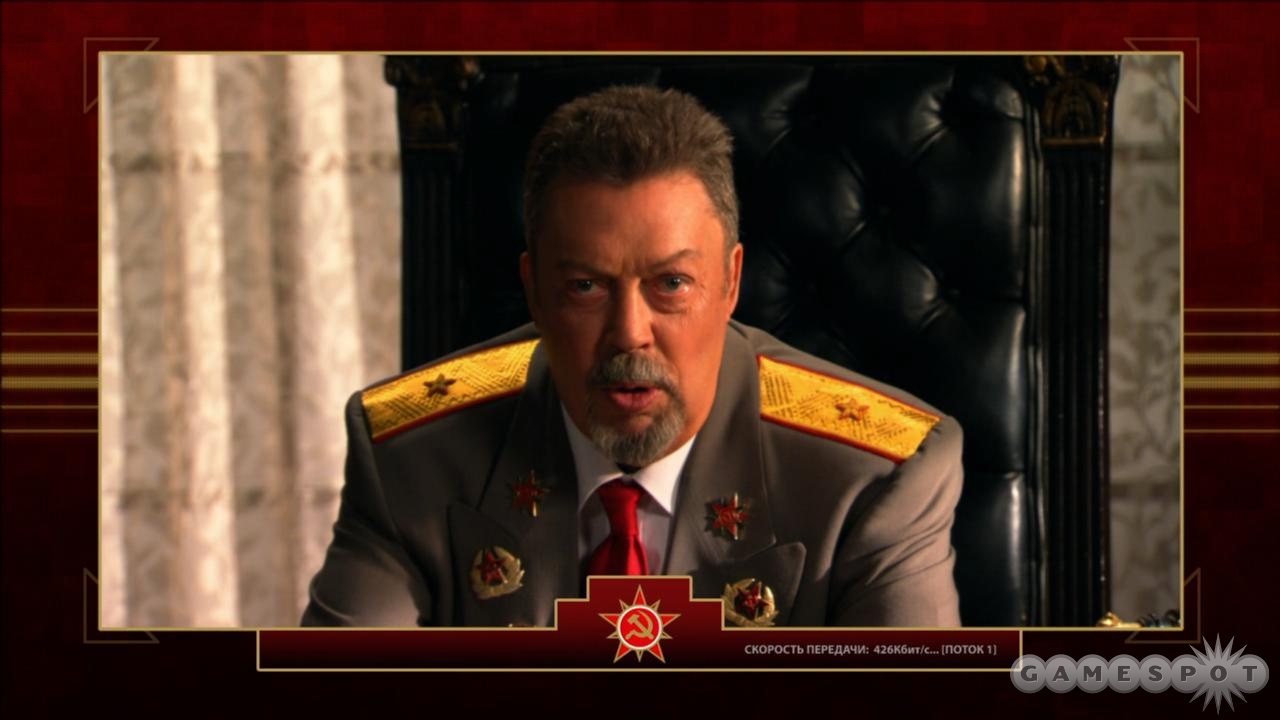Where else but in the Red Alert universe could you pit transforming mechs against bears, or decide the fate of your mission by attacking floating fortresses with intelligent dolphins outfitted with sonic disruptors? Command & Conquer: Red Alert 3 doesn't take itself seriously, but that's what makes it so much fun to play. This is the most rambunctiously over-the-top strategy game to reach store shelves in years, filled to the brim with laugh-out-loud cheesiness and a cheerful disregard for political correctness. Underneath that kookiness is a fairly standard RTS with some noticeable flaws, but it's a great one nevertheless, thanks to entertaining units, a strong multiplayer component, and support for an online, fully cooperative campaign--a first for the genre.
So here's the setup, told in a hysterically overacted cutscene that could have been ripped directly from a bad sci-fi flick: Russian leaders, including the premier (played by a heavily accented, wonderfully hammy Tim Curry) travel back in time to kill Albert Einstein. The theory is that doing so will change the course of history, causing the Soviet Union to dominate as a world power. Instead, this bit of time tampering gives rise to a new threat, the Empire of the Rising Sun--and, of course, more broadly played histrionics. The whole thing is a live-action riot: JK Simmons as US President Ackerman is all anticommie swagger, and George Takei scrunches his face into superserious knots as the Emperor. Then there is Jenny McCarthy as Tanya, stroking an enormous toy gun in one scene, holding a sexy pose but still prepared to slit a man's throat in another. Skimpy, ill-fitting costumes, blatant computer-generated graphics, and bad accents--it's all quite wonderful, with tongue firmly planted in cheek.
All three factions--Soviets, Allies, and Empire--are fun to play, and though not dramatically different from each other, they’re distinct enough to make each of them feel fresh. For instance, Allied structures can be placed only after fully completed within the build queue (a standard C&C mechanic), whereas Soviet refineries can be placed immediately and assembled afterward. The new faction for the franchise, Empire of the Rising Sun, is even more flexible in this regard, but it also requires a bit of micromanagement. In this case, you queue up movable vehicular pods called cores that then unfurl into the appropriate structure. Additionally, most Empire structures (with the exception of defensive turrets) can be placed anywhere without the fetters of a nearby base, which makes them the easy choice for players who like to establish an early presence across the entire map. Of course, these differences extend to ore refineries, but in all cases, resource collection is more measured than in prior C&C games. Gem fields are gone, which makes ore mines your only source of income. The method of implementation is a departure for the Red Alert franchise, given that it generally means a one-to-one ratio of ore collectors to refineries and a resulting slower pace.
Nevertheless, a slower economy doesn't make for less explosive gameplay, and each faction boasts a number of awesome units to throw into the fray. Some of them, such as attack dogs and flak troopers, are carryovers from previous games. But no matter whether you're using familiar units or new ones, clashes are fiery and tense, especially when you've grasped the nuances of each unit's secondary mode. This is particularly true when playing as the Empire, considering that most of its units are more than meets the eye; they transform between two distinct states with differing strengths. For example, the mecha tengu can attack infantry from the ground or do antiair duty in the skies. This flexibility translates to most Empire units, making them fun to use as long as your finger is hovering near the F key on your keyboard, which toggles between unit abilities.
This isn't to say that Soviet and Allied units aren't equally entertaining to use. All factions use ground, air, and sea units, with many of them doing double duty in water and on land. For example, the ever-helpful Soviet bullfrog can transport troops across land and water (and can amusingly spew infantry a good distance with its man-cannon). Late-game skirmishes bring the best and most fun-to-use units, such as the Allied aircraft carrier, which sends a squadron of drones into the fray and is one of Red Alert 3's most autonomous naval units. The campaign introduces these units with style, and the size to which some of its maps expand will often keep you busy across the entire map, particularly during the frantic final missions.

The gameplay twist within the campaign is the addition of a co-commander. If you play on your own, this position will be granted to an AI player of a fair level of competence, and you'll be able to issue basic one-click commands, such as "hold this spot" or "attack this structure." There are also some contextual commands when mission objectives get more intricate and require very specific actions, such as destroying a reactor or capturing a building. This addition makes the largest campaign missions feel wonderfully dramatic, with engagements scattered across the map involving not just your own units but friendly ones as well. It also adds a bit more oomph to the light puzzle-solving missions so common to the genre ("take these three units and follow these specific instructions"), because it requires the assistance of your compatriot. On the other hand, it makes the campaign easier than you would expect, seeing as how your AI comrade will usually buy you enough time to rebuild if you make a costly mistake.
But as with most games, it's better to add a real friend than deal with the occasional questionable decisions of an artificial teammate, and Red Alert 3's greatest asset is its cooperative campaign, a first for the genre. Should you go this route, your online partner (co-op play is unavailable on a local network) will take the role that the AI otherwise would, making the specific objectives mentioned above even more satisfying. It's a treat to play this way, and as you can imagine, completing a mission with a real-life counterpart is more compelling; it's a wonder that strategy games haven't attempted this sort of venture before. Unfortunately, getting another player into the match is a bit cumbersome. You must choose the mission and then enter the online lobby to issue the invitation, and when you invite the player, the game offers no feedback to let you know that the invite has been sent. The invited player does receive a notification pop-up and an invite notice, though there are times when the invitee won't receive an issued invitation, for no discernible reason.
Although the single-player/co-op campaign is great, multiplayer should give Red Alert 3 the same longevity that Tiberium Wars and Kane's Wrath have enjoyed. This is where the strengths and weaknesses of each unit become clear, and where distinct faction differences are even more palpable. For example, should you play Empire, you'll find that the lack of early-game antiair units makes you extremely vulnerable to Allied air attacks. As a result, immediate base harassment is all but necessary, unless you want your ore collectors and refineries to face early retirement while you spend funds on tech that will unlock the necessary units. Compared to previous Command & Conquer games, Red Alert 3 matches are more measured, thanks to the slower economy. This means fewer early rushes and greater emphasis on scouting, as well as a better chance to get the most interesting units into the mix. The big game-changer here are special powers, which can be terribly devastating and can dramatically turn the tide of the match.

There are 28 maps on which to play, an impressive number indeed. The best of these, such as Secret Shrine and the cleverly named Reef Madness, pleasantly mix land, sea, and air combat thanks to varied terrain that encourages entertaining mixes of units. All in all, Red Alert 3 is, with a few exceptions, relatively well balanced and thus an obvious choice for competitive strategists who wish to showcase their battle prowess online. Ladder and clan matches are available and function much the same way as they did in Command & Conquer 3, and as before, the in-game BattleCast option lets you broadcast your game to others, even allowing for someone to provide on-the-fly commentary. Like C&C3, it even comes with telestrator tools that let you draw directly over the match in progress like a sports commentator giving a play-by-play. If you need offline practice, you can skirmish against the AI, though the short live-action video intros that obscure the minimap when you encounter an opponent were a bad idea here. These portraits are a fun feature of the campaign but are annoying during stand-alone skirmishes when the need for a functioning minimap far supersedes any amusement that these scenes provide.
The overall Red Alert 3 experience is a raucous one, but it lacks the technical tightness featured in the last few Command & Conquer games. Pathfinding is probably the most noticeable and annoying issue, particularly when amphibious units are involved. Units get stuck jogging in place against a wall or stopping at the edge of a plateau, and the addition of water to the terrain seems to confuse them even more. We also ran into a number of glitches: Units clipped into bridges and got stuck, performed incorrect animations (for example, units would swim across land), and in several skirmish games, we could pull the camera out indefinitely until the screen went black.
Red Alert 3's visuals pop right off of the screen. The colors are bright and vivacious, and therefore perfectly suited to the game's in-your-face mirth. Tropical maps are drenched in golden light, and multicolored beach umbrellas dot the shores, both contributing to and contrasting with the visual splendor of exploding hammer tanks. They also feature possibly the finest water effects yet seen in an RTS game, and the sunlight dances pleasantly on the turquoise waves. Electrical effects such as those emitted by Tesla coils also deserve particular mention for the flashiness of their violent zaps. Units are detailed and the most unusual ones look really cool, so though Red Alert 3 doesn't push a lot of polygons, its lovely design brings a modern look to an older franchise while running smoothly on a variety of systems. One interesting graphical feature is the yellow outline that surrounds selected units, which is a neat choice but a double-edged sword. On one hand, it lets you easily identify your own selection on the screen and can be a welcome visual cue. On the other, the outline is a bit too thick, which makes it difficult to identify which type of units you've selected. It also makes it easy to get confused if a competitor chooses yellow as his or her unit color in a multiplayer match.

Along with buoyant visuals comes an upbeat soundtrack featuring a fun mix of ambient music and rocking battle cues, not to mention an array of boisterous explosions. Although much of it is unremarkable, there are some real standouts used during the campaign, such as a flowing new-age track used in Soviet missions, and some jolly Asian-inspired themes that set the mood during the Empire campaign. And what would a Command & Conquer game be without fun unit responses? When special unit Natasha asks if you like her scope in that thick, fake Russian accent, it's hard not to let out a guffaw.
A few problems aside, Red Alert 3's cooperative campaign and cool new faction offer plenty of enjoyment for players who don't mind a little cheese with their meat. This isn't exactly the genre's next step forward, but it's a slick and entertaining evolution of a classic franchise that's hard to dislike. Rest assured, that quirky exterior masks a strong campaign and an equally substantial multiplayer component that will keep you and your dolphins busy well into 2009.
